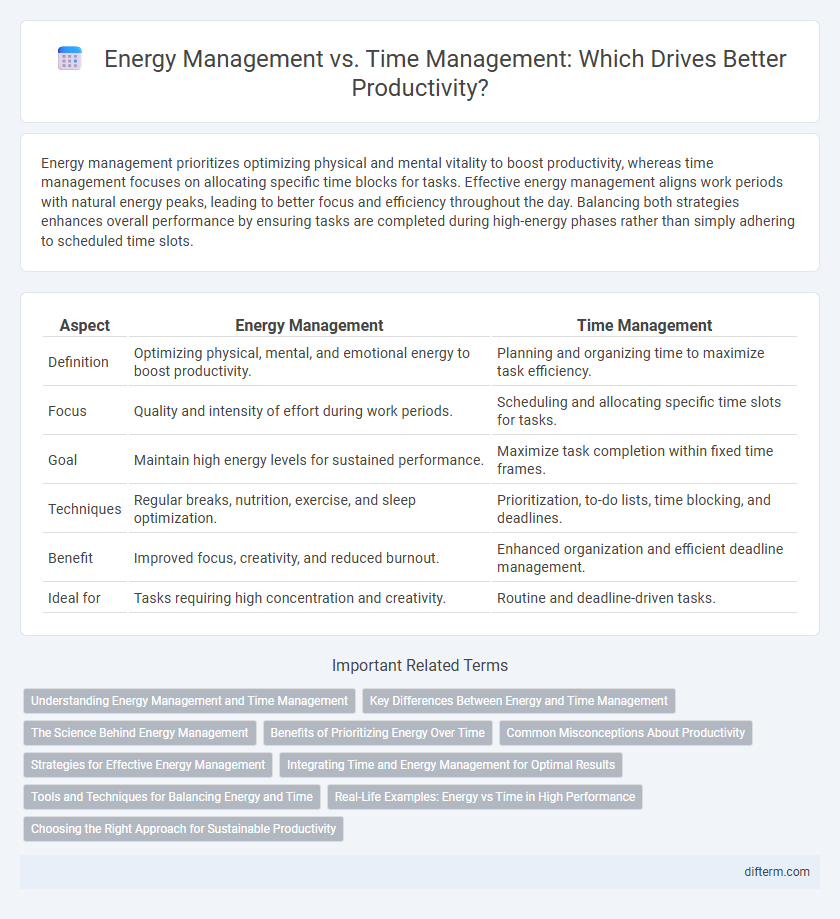Energy management prioritizes optimizing physical and mental vitality to boost productivity, whereas time management focuses on allocating specific time blocks for tasks. Effective energy management aligns work periods with natural energy peaks, leading to better focus and efficiency throughout the day. Balancing both strategies enhances overall performance by ensuring tasks are completed during high-energy phases rather than simply adhering to scheduled time slots.
Table of Comparison
| Aspect | Energy Management | Time Management |
|---|---|---|
| Definition | Optimizing physical, mental, and emotional energy to boost productivity. | Planning and organizing time to maximize task efficiency. |
| Focus | Quality and intensity of effort during work periods. | Scheduling and allocating specific time slots for tasks. |
| Goal | Maintain high energy levels for sustained performance. | Maximize task completion within fixed time frames. |
| Techniques | Regular breaks, nutrition, exercise, and sleep optimization. | Prioritization, to-do lists, time blocking, and deadlines. |
| Benefit | Improved focus, creativity, and reduced burnout. | Enhanced organization and efficient deadline management. |
| Ideal for | Tasks requiring high concentration and creativity. | Routine and deadline-driven tasks. |
Understanding Energy Management and Time Management
Energy management focuses on optimizing physical and mental vitality to sustain high productivity levels throughout the day, while time management prioritizes organizing tasks within a fixed schedule to meet deadlines. Understanding energy management involves recognizing peak energy periods and aligning demanding activities accordingly, in contrast to time management which emphasizes planning and prioritizing tasks by importance and urgency. Balancing both strategies enhances overall productivity by ensuring tasks are completed efficiently without depleting vital energy resources.
Key Differences Between Energy and Time Management
Energy management prioritizes optimizing physical and mental vitality to sustain high performance throughout the day, whereas time management focuses on allocating fixed time slots to tasks. Key differences include energy management's emphasis on rest, nutrition, and exercise to maintain focus, contrasting with time management's reliance on scheduling and deadlines to increase efficiency. Effective productivity incorporates both by aligning task demands with periods of peak energy for maximum output.
The Science Behind Energy Management
Energy management leverages circadian rhythms and bioenergetics to optimize focus and efficiency, emphasizing periods of peak alertness over fixed schedules. Studies in chronobiology reveal that aligning tasks with natural energy fluctuations enhances cognitive performance and reduces burnout. Neuroscience shows that managing energy inputs, like nutrition and sleep, directly impacts mitochondrial function, which fuels mental and physical productivity.
Benefits of Prioritizing Energy Over Time
Prioritizing energy management over time management enhances sustained focus, creativity, and overall productivity by aligning tasks with natural energy peaks. Managing energy allows for strategic rest and recovery, reducing burnout and improving mental clarity during high-demand periods. This approach optimizes work quality and efficiency beyond rigid scheduling, fostering long-term achievement and well-being.
Common Misconceptions About Productivity
Energy management focuses on optimizing physical and mental resources to maintain consistent productivity, contrasting with time management's emphasis on scheduling tasks. Common misconceptions claim that managing time alone guarantees efficiency, overlooking the crucial role of replenishing and balancing energy levels throughout the day. Research from the American Psychological Association highlights that prioritizing energy management reduces burnout and enhances sustained focus, proving it essential for true productivity.
Strategies for Effective Energy Management
Effective energy management strategies prioritize identifying personal peak energy periods to schedule high-focus tasks, thereby maximizing productivity and reducing burnout. Integrating regular breaks, physical activity, and proper nutrition helps sustain energy levels throughout the day, enhancing cognitive function and concentration. Utilizing tools like the Pomodoro Technique and energy tracking apps further supports maintaining optimal energy allocation for complex projects.
Integrating Time and Energy Management for Optimal Results
Integrating time and energy management enhances productivity by aligning tasks with personal energy peaks, maximizing focus and efficiency throughout the day. Prioritizing high-energy periods for demanding activities and scheduling low-energy times for routine tasks optimizes overall performance and reduces burnout. Using tools like energy audits alongside time-blocking techniques ensures balanced workload distribution and sustained motivation.
Tools and Techniques for Balancing Energy and Time
Effective productivity relies on integrating energy management tools like the Pomodoro Technique with time management methods such as time blocking to optimize performance. Utilizing wearable devices to monitor physical energy levels helps tailor work intervals to peak productivity phases. Apps like RescueTime and Toggl assist in tracking time spent on tasks, enabling a balanced approach that aligns energy fluctuations with scheduled activities.
Real-Life Examples: Energy vs Time in High Performance
High-performing individuals like athletes and CEOs prioritize energy management over traditional time management by aligning tasks with their natural energy peaks, resulting in enhanced focus and productivity. For example, executives schedule critical decision-making during morning hours when mental clarity is highest, while reserving routine emails for lower-energy periods. This approach leverages natural energy rhythms to maximize output, demonstrating that managing energy yields superior performance compared to mere time allocation.
Choosing the Right Approach for Sustainable Productivity
Energy management prioritizes aligning tasks with natural energy fluctuations to maximize focus and output, while time management emphasizes structuring tasks within specific time blocks. Sustainable productivity thrives by integrating energy rhythms, reducing burnout, and enhancing work quality rather than solely optimizing hours worked. Selecting an approach tailored to individual energy patterns fosters long-term efficiency and well-being.
Energy management vs Time management Infographic

 difterm.com
difterm.com